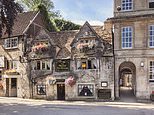
Britain at its best: Discovering why ravishing Bradford on Avon is much more than a miniature replica of BathThe Daily Mail’s Kate Wickers took a tour of Bradford on Avon in Wiltshire with a local historian For six centuries, the town was known for its cloth industry and the great mills of the 18th centuryThe Lock Up is a medieval chapel that was used as an overnight cooling-off station for the town’s drunkards
Advertisement
Made with Bath stone?’ I ask Ivor Slocombe, a local historian, who is giving me a tour of Bradford on Avon in Wiltshire.
We’re gazing up at the monumental edifice of what began life in 1854 as the Town Hall designed by Thomas Fuller, who mixed Gothic, Tudor and Jacobean architectural elements, crowning it with an onion dome. It is now the Roman Catholic Church of St Thomas More.
‘Not only Bath; Bradford stone, too,’ he replies. ‘There were several limestone quarries just nearby.’
A cup of good cheer: The evocative 16th-century Bridge Tea Rooms in Bradford on Avon
Bradford on Avon is often referred to as ‘Bath in miniature’, but for local people this is an irksome analogy as clearly the town is much more than a bijoux replica.
For six centuries, it was known for its cloth industry and the great mills of the 18th century, and grand mansions (once belonging to wealthy merchants) still dominate. We pass through The Shambles — a crooked narrow street lined with timber-framed buildings — that takes its name from the Anglo-Saxon word scamel, a bench used by traders to display produce.
Nearby is the nine-arch Town Bridge, where Saxons drove their carts across a ‘broad ford’ (the River Avon) from which the town takes its name.
Sitting pretty in the middle is the Lock Up — a medieval chapel that was later used as an overnight cooling-off station for the town’s drunkards and troublemakers. ‘We have a saying here that if you are under the fish and over the water, you’re in jail,’ Ivor tells me, referring to the gudgeon (a freshwater fish) found on The Lock Up’s weathervane.
The bridge was doubled in width in 1767 because people kept falling into the river. The two ribbed and pointed arches of the original can be seen on the eastern side.
When the cloth trade fell into decline in the late 19th century, Victorian entrepreneur Stephen Moulton bought up redundant mills and began his production of rubber goods.
Pictured is the Town Bridge, where Saxons drove their carts across a ‘broad ford’ (the River Avon) from which the town takes its name
The gardens of Moulton Hall, a grand Jacobean house built in 1600, are bordered by a cycle track installed by Moulton’s grandson, Alex Moulton, in the 1960s, which he used to trial Moulton bicycles, still manufactured in the town today.
The 14th-century Tithe Barn is described by English Heritage as Britain’s most impressive, and was used by wealthy landowners to collect tithes (taxes), paid for in livestock and produce.
It runs 168 ft long and 33 ft across with a vast timber roof of A-shaped trusses supporting roof tiles that weigh more than 100 tons. The patterns of interlocking circles, found in the stonework near the barn’s immense wooden doors, are there to ward off witches. Behind here, pleasure barges putter at a sedate speed along the Kennet and Avon canal, part of an 87-mile waterway linking the River Kennet at Reading with the River Avon at Bath.
‘Bradford on Avon is often referred to as ‘Bath in miniature’, but for local people this is an irksome analogy’, writes the Daily Mail’s Kate Wickers
Over the Packhorse Bridge, I make the knee-crunching climb through rows of weavers’ cottages to pretty St Mary Tory (as in Tor, meaning hilly peak). From here, the whole town spreads out before you and beyond to the Marlborough Downs and Mendip Hills. Nearby is St Mary’s Chapel, where pilgrims would stop for a breather on their way to Glastonbury.
Ask Ivor what Bradford on Avon’s star attraction is, and he’ll direct you to the Church of St Laurence, one of the most complete Saxon buildings in existence. It has a stark beauty — tall and narrow, with slender archways.
On the riverside area near to Lamb Yard, once the town’s industrial heart, you’ll find what is light-heartedly referred to as The ‘Bradford Riviera’. At Pablo’s Bistro, I order a G&T and watch as the late afternoon sun turns the Bradford stone walls from a warm buttery yellow to radiant gold. Just the one though, as I don’t want to end up in the Lock Up.
Advertisement
Share or comment on this article:
Source link
CHECK OUT: Top Travel Destinations
READ MORE: Travel News



